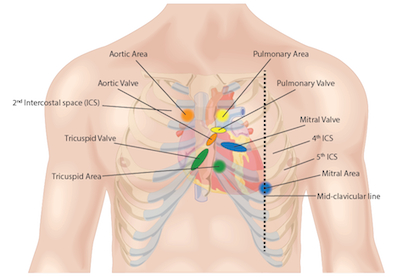심장 검사 II: Auscultation
Overview
출처: Suneel Dhand,MD, 주치의, 내과, 베스 이스라엘 Deaconess 의료 센터
심장 소리를 듣기 위해 청진기를 사용하는 능력과 정상 및 비정상적인 심장 소리를 구별하는 능력은 모든 의사에게 필수적인 기술입니다. 가슴에 청진기의 올바른 배치는 닫는 심장 판막의 소리에 해당합니다. S1과 S2 : 심장에는 두 가지 주요 소리가 있습니다. 첫 번째 심장 소리 (S1)는 혈액이 심실에 들어간 후 모성 및 트리쿠스 피밸브 (대상 동맥 판막)가 닫히면서 발생합니다. 이것은 systole의 시작을 나타냅니다. 두 번째 심장 소리(S2)는 혈액이 심실을 떠난 후 대동맥 및 폐 밸브(반달 판막)가 닫히면 실소 끝에 전신 및 폐 순환 시스템에 진입하게 된다. 전통적으로 소리는 "lub-dub"로 알려져 있습니다.
심혼의 오서큘레이션은 청진기 가슴 조각의 다이어프램과 종 부분을 모두 사용하여 수행됩니다. 다이어프램은 가장 일반적으로 사용되며 고주파 소리 (예 : S1 및 S2)와 승모 역류 및 대동맥 협착증의 중얼거림에 가장 적합합니다. 다이어프램은 가슴 벽에 단단히 눌러야 합니다. 종은 저주파 소리 (예 : S3 및 S4)와 승모 협착의 중얼거림을 가장 잘 전달합니다. 종은 가벼운 압력으로 적용되어야합니다.
Procedure
1. 환자를 30-45도로 배치합니다.
2. 조사 중인 영역이 노출되어 있는지 확인하고 가운을 통해 결코 소란을 피하지 마십시오.
3. 정의된 해부학 적 랜드 마크에 청진기를 놓습니다(그림 1). 두 번째 늑간 공간을 찾는 엄지 손가락의 좋은 규칙은루이 (manubriosternal 관절)의 각도를 찾는 것입니다, 이는이 수준에있는. 손가락으로 위아래로 팔파테하여 설명된 다른 늑간 공간을 찾습니다.

그림 1. 공해 표면 랜드 마크.
- 대동맥 지역
- 청진기의 다이어프램을2nd 늑간 공간, 오른쪽
Application and Summary
심장의 Auscultation은 모든 임상의가 마스터하는 근본적인 기술 중 하나로 남아 있으며 많은 심장 이상에 중요한 진단 단서를 제공합니다. 법선과 병리학을 구별하기 위해서는 올바른 기법을 배우는 것이 필수적입니다. 모든 심장 영역은 구조화되고 체계적인 방식으로 서술되어야 합니다. 물리적 인 사실 인정은 심장 주기에 관하여 해석되어야 하고, 각 소리의 강렬, 기간, 피치 및 타이밍은 주의되?...
건너뛰기...
이 컬렉션의 비디오:

Now Playing
심장 검사 II: Auscultation
Physical Examinations I
140.1K Views

신체 시험에 대한 일반적인 접근 방식
Physical Examinations I
117.6K Views

관찰 및 검사
Physical Examinations I
95.1K Views

촉진
Physical Examinations I
84.5K Views

타악기
Physical Examinations I
101.8K Views

청진
Physical Examinations I
62.3K Views

신체 검사 중 환자 복장의 적절한 조정
Physical Examinations I
83.4K Views

혈압 측정
Physical Examinations I
108.8K Views

활력 징후 측정
Physical Examinations I
115.0K Views

호흡기 검사 I: 검사 및 촉진
Physical Examinations I
157.4K Views

호흡기 검사 II: 타악기 및 오스컬레이션
Physical Examinations I
213.0K Views

심장 검사 I: 검사 및 촉진
Physical Examinations I
176.6K Views

심장 검사 III: 비정상적인 심장 소리
Physical Examinations I
91.9K Views

말초 혈관 시험
Physical Examinations I
68.8K Views

연속 파 도플러를 이용한 말초 혈관 시험
Physical Examinations I
38.6K Views
Copyright © 2025 MyJoVE Corporation. 판권 소유